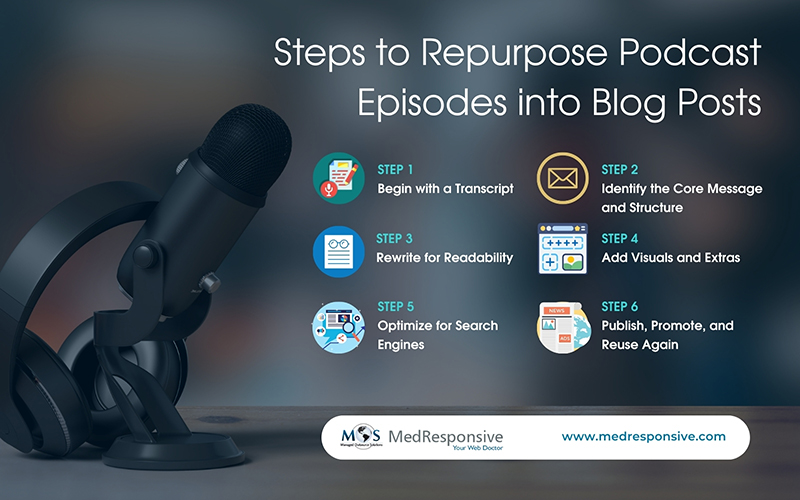Let’s start with a wild fact:
There are currently over a staggering 6.5 million podcasts out there, with an equally impressive 584 million listeners.
However, the majority of that content remains trapped in audio—an untapped goldmine for SEO, marketing and most importantly, blogs. So, here’s the big question:
Are you letting your podcast content rot in the rush of webpages after a single listen?
Yes, people may be more inclined to listen to a content than read it, but that doesn’t mean that there isn’t an audience for blogs or to undermine the significant role they play in boosting search rankings and SEO. And, If you’re not taking the time to repurpose podcasts into blogs, you’re missing out on a major opportunity to expand your reach, connect with a wider audience, and increase your online visibility. .
Think about it: your podcast is already rich with ideas, insights, and value-packed discussions. By turning audio content into text, you’re not starting from scratch. You’re leveraging what you’ve already created and making it work harder for you.
This post walks you through how to repurpose podcasts into blog posts, step by step. It doesn’t matter if you’re a content creator, a marketer, or a business owner, this guide is your shortcut to turning spoken words into powerful text content.
The Significance of Repurposing Podcast Content
Before we address the “how”, let us explore the “why.”
- Enhance SEO for Podcast Content: The issue here with audio is that search engines don’t (yet) index audio. However, it does with text. Transcribing your podcast and shaping it into a post lets you use keywords, meta tags, and headers that push you up in search rankings.
- Reach a Wider Audience: Yes, the audio fan base is growing but it isn’t everyone’s cup of tea. A lot of them still prefer reading as they don’t have the time or circumstance to listen to a podcast or an audiobook. Blogs give those people access to your content.
- Make Your Content Do the Work: You clearly know the time and effort that has gone into producing and publishing the audio content. Repurposing lets you squeeze more value out of it via blog posts, social media, email campaigns, and more.
- Establish Authority: Text content gives you the chance to modify and polish your content with fresh, up-to-date ideas, include missing citations or links or add something quirky, thereby demonstrating your knowledge. This builds credibility with readers.
How to Repurpose Podcast Episodes into Blog Posts
Now let’s get to the good stuff. Here’s a practical, repeatable workflow to help you transform your podcast episodes into valuable, readable blog content.
Step 1: Begin with a Transcript
Transcribe the particular episode. This gives you a full script to work from, saving time and helping you keep the core message intact. And now with a plethora of AI tools in the market, podcast transcription for blogs is child’s play.
Tools to use:
You don’t have to particularly worry about making it perfect, as the task here is to get the words down. You can shape them later.
Step 2: Identify the Core Message and Structure
Once you have the transcript, read through it and extract key ideas. Ask questions like:
- What’s the episode about?
- What are the main takeaways?
- Are there any strong quotes or stories worth highlighting?
From there, sketch out a rough blog outline. A solid structure makes your post easier to read and more enjoyable to follow.
Basic blog structure:
- A strong intro that sets the tone
- Key themes broken into sections
- Supporting quotes, stories, or stats
- A conclusion with a call-to-action (CTA)
Step 3: Rewrite for Readability
Copy-pasting the transcript and the work’s done? Absolutely not. A transcript isn’t a blog post because spoken language reads differently from text content. When writing the blog:
- Cut filler words like “um,” “you know,” or long tangents
- Tighten up sentences for clarity
- Break up paragraphs to keep it scannable
- Use subheadings and bullet points to organize thoughts
Your goal here is to translate, not just transcribe. Make sure to keep the tone and voice from the podcast, but deliver it in a format that suits readers.
Step 4: Add Visuals and Extras
A wall of text can be overwhelming. Keep your post engaging with:
- Images or infographics
- Pull quotes from the podcast
- Relevant links to other blog posts or resources
- Embedded audio of the podcast episode
If you mention a product, tool, or case study in the episode, link to it. This boosts both SEO and credibility.
Step 5: Optimize for Search Engines
Now that you’ve got a solid draft, it’s time to make it discoverable.
Here’s what to check off:
- Title: Include your target keyword. Keep it clear and clickable.
- Meta description: A short summary with your main keyword.
- Headers (H1, H2, etc.): Break up content and guide readers.
- Keyword placement: Use naturally throughout the post.
- Alt text: Add to images for accessibility and SEO.
You don’t need to go overboard—just make sure it reads naturally and hits the basics.
Step 6: Publish, Promote, and Reuse Again!
Hit publish—and then don’t stop there.
Promote your blog post via:
- Social media snippets
- Email newsletters
- LinkedIn articles or Medium reposts
- Including it in podcast show notes
And guess what? That blog post can now be repurposed further into tweets, carousels, or even short videos.

Bonus Tips to Enhance Your Podcast Blog Strategy
- Batch your workflow: Do several transcripts at once and outline multiple posts.
- Quirky Marketing: Use podcast quotes as social media teasers
- Release: Republish on multiple platforms (with canonical tags)
- Monitoring: Track what topics perform best so you can refine your podcast content marketing.
The key is to think of each podcast episode as a content seed—you can grow multiple formats from it, with the blog being one of the most powerful.
A Sample: Podcast-to-Blog Breakdown
Let’s say your podcast episode is titled: “The Future of Telehealth: Challenges and Opportunities”
When you are repurposing it into a blog, the components should be:
Title: “Telehealth Trends 2025: What’s Next in Remote Care?”
Subheadings:
- What Is Telehealth and Why It’s Booming
- The Top “n” Challenges in Telehealth Today
- Expert Insights from Our Podcast Guest
- What Healthcare Providers Should Expect Next
- Listen to the Full Episode Here
This blog now serves readers who want quick insights and also pushes listeners back to the original episode.
Work Smarter with MedResponsive
If all this sounds like a lot, we don’t blame you. Repurposing podcasts into blog posts takes time, skill, and a knack for storytelling.
That’s where we come in.
Why Choose MedResponsive?
- Expertise: Our team understands the nuances of both audio and text content.
- Boost Your SEO: Enhance your online visibility with optimized blog posts.
- Expand Your Reach: Connect with audiences who prefer reading over listening.




